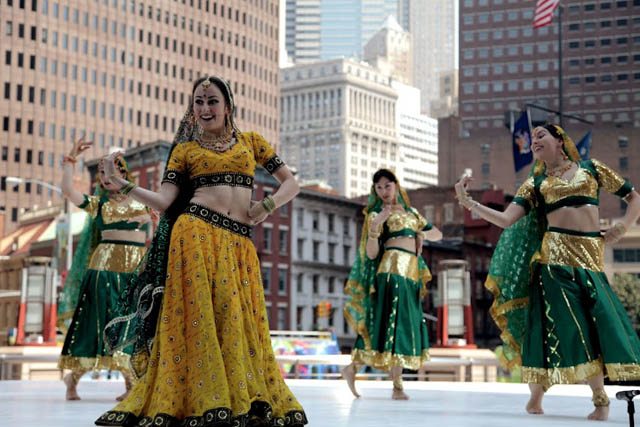
Indian Dance Kicks Up Its Heels in Downtown NYC
On this golden summer afternoon, it seemed quite a good option to be jobless, a tourist or a window shopper browsing the Financial District rather than a hedge fund guy or a banker immersed in a dry office!
In a surreal juxtaposition, sparkling Bollywood, Indian music and dance had come to NYC’s downtown business area, with costumed dancers doing high kicks against the skyscrapers and bringing the ‘nakras’ and ‘chakras’ of Indian dance to this rather sober part of town.
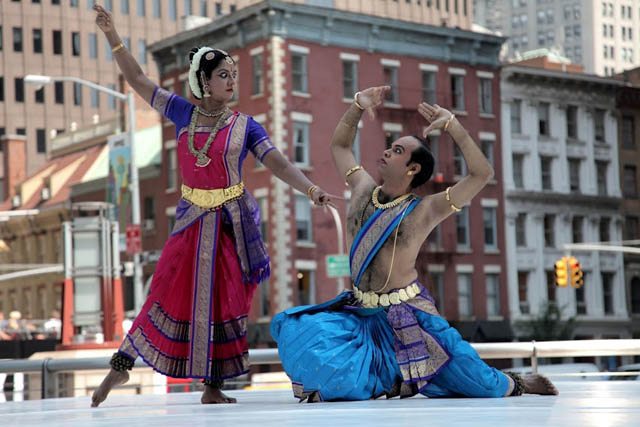
Tourists gaped from the top of open double decker tourist buses which rolled past the plaza with its unexpected celebration of Bharat Natyam, Kuchipudi, Kathak and ‘filmi’ Bollywood dance. Right on One New York Plaza was Erasing Borders: Festival of Indian Dance, a free event co-presented by the Indo-American Arts Council and Battery Dance Company as part of the 31st Downtown Dance Festival.
As Jonathan Hollander, Director of Battery Dance Company put it, dance needs to be more accessible and this was a wonderful way to taste the array of dance companies presented out in the open. Aroon Shivdasani, artistic director of the IAAC introduced dance which had its roots in India but had found its way to New York in roundabout ways.
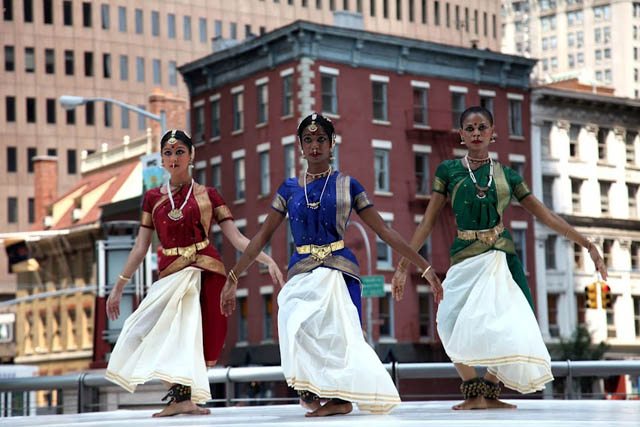
Jaikishore and Padmavani Masalikanti, who held the audience captive with the powerful triumph of the Goddess Durga over Mahisha, and later an enticing ‘thali’ dance, were the only ones who were directly from India.
Indeed, the fact that Indian dance in all its forms has pirouetted all across the Indian Diaspora and beyond was obvious from the back stories of the dancers in the plaza: Bageshree Vaze, the graceful Kathak dancer is a native of Pune but has grown up in Canada and her latest Damaru/Mudhra had premiered at the Harbourfront Center in Toronto.
Sonali Skandan and the Jiva Dance are very much a part of New York, bringing their own sensibilities to the ancient dances of Bharat Natyam. In fact, one of the dancers was from Nigeria. Sonali Skandan, Artistic Director of Jiva Performing Arts is on the dance facility of Sarah Lawrence College and has been involved with the Heritage School in Manhattan. She presented works she had choreographed – highlighting Swarupa, the infinite form, through expression and abstract dance.
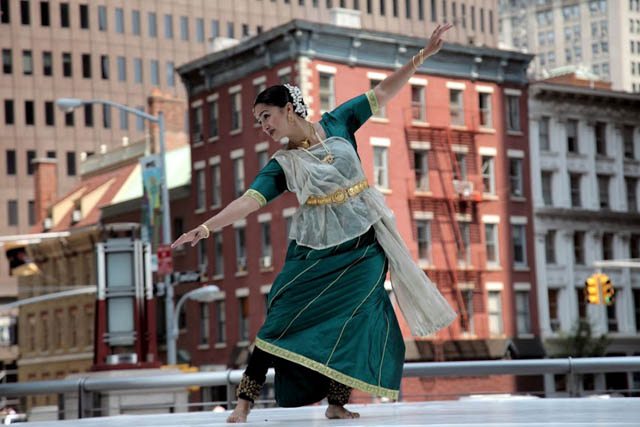
Perhaps the most eye-popping dance-travel story was that of the Mayuri Dance Group from Russia. These stunning dancers dazzle with Bollywood numbers as if they’ve been weaned on them, and many of them speak Hindi, Rajasthani and Punjabi too! Indeed, theirs’ is a dramatic case history of how Bollywood has infiltrated other cultures.
Russia has had a long love affair with Hindi cinema, starting with Raj Kapoor movies in the 50’s. The history of the Mayuri Dance Company goes back to the creation of an Indian culture studio by Vera Evgrafova at the Railway Workers Cultural Center of Petrozavodsk. So intense is their devotion to Indian cinema that the company was named after an obscure film few film aficionados will remember – ‘Mayuri’, starring Sudha Chandran, a dancer who actually lost her leg in a car accident and lived to have a sterling career in cinema with a ‘Jaipur foot’.
(It gave me goose bumps to realize that many years ago I had interviewed this very dancer – Sudha Chandran – when she had visited New York and told me the story of her accident and subsequent ordeal! Hindi cinema and the Diaspora are indeed intricately connected. )
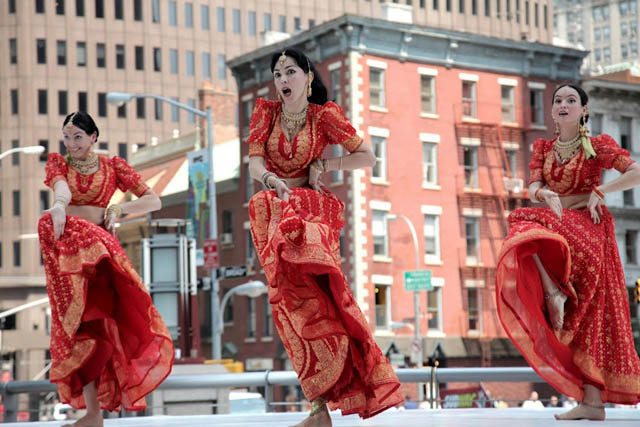
Mayuri Dance Company showed its expertise with several eye-catching and foot-tapping numbers from Bollywood, from ‘Nimura’ to ‘Chamak Chalo’, including the classic Geeta Dutt number, ‘Mera Naam hai Chin Chin Choo’ which is from the Ashok Kumar-Madhubala starrer ‘Howrah Bridge’ and which was immortalized by the one and only Helen. Yet here the young Russian dancer brought her own choreography and joie de vivre to this number. The exuberant dancers even did a bhangra in drag, bringing audience members to join in a joyous free for all on the stage, with the boisterous, “Jat Ho Gaya Sharabi.”
So profound is the influence of Bollywood on different nations that Petrozavodsk even has an Indian cinema fan club operating under the “Karelia-India” Friendship Society which once a week shows Hindi cinema to the Russian fans.
Curious to pursue more of this Russian love story, I caught up with the dancers as they were headed to the airport and did a phone interview with Elena Siskovets, who even has a Hindi first name, Pali.
A Russian Dancer’s Story
“I loved Indian dance from childhood – I used to watch a lot of Hindi movies!” said Elena, whose Hindi is even more pure and precise than mine. She said she first got to see Indian dance in the Festival of India which took place in the Soviet Union in 1987. Many dance troupes had come and Elena was blown away by the bharata natyam.
Mayuri Dance Group – (Video by Rajika Puri)
The founder of the group Vera Evgrafova had many books and Elena learned Hindi from books and from the many Hindi movies she saw. She credits the old Hindi movies like Dilip Kumar-Vyjantimala starrers such as ‘Sunghursh’ with teaching her perfect Hindi since in these films the dialogue was not mixed like in contemporary cinema.
While Raj Kapoor was the one who popularized Hindi cinema in the Soviet Union, today Amitabh Bachchan as well as all the Khans are very popular, while audiences love the classic dances of Rekha and Hema Malini, more than contemporary dance.
Why have Russians got so hooked on to Hindi cinema and dance? Elena’s theory is that in her town in the north there is a shortage of color and India is full of colors. It is the children who get hooked on to Indian dance and convince their parents to enroll them in the dance school. In this small town over 500 students learn Indian dance, with many adults joining in. Elena’s own personal favorites of the Hindi film industry are Padmini, Ragini and Rekha. While they create choreography for most of the songs, some they keep intact, as a tribute, such as Rekha’s numbers from ‘Umrao Jan.’
Interestingly, Bollywood is traveling from Russia all the way to the Indian Diaspora, with Mayuri Dance Company performing in many parts of the US, getting raves for numbers such as ‘Kajra Re’ and ‘Chikni Chameli’. And yes, such is the power of Bollywood, these dancers have traveled via Russia to Chandigarh, India, enthralling audiences with their bhangra numbers!
Not only can Bollywood dance, it seems, but it can also fly…
Related Articles:

4 Comments
Hi Prem – yes, that would be a solution to many of the world’s problems. You have to smile when you dance – and if you’re smiling and happy, you really have no room for the negative emotions.
So much energy, enthusiasm and love for the dance! Perhaps dance should be taught in every school/university around the world. How can you think of hatred, terrorism, racism, or ill will when everyone dances together?
Well said, Kirit! The passionate way in which these dancers have adopted not only Bollywood dance but all forms of Indian dance is really amazing. They have studied all aspects, from books to cinema.
Seeing this Bollywood Dance on foreign soil by Russian artists is really heartwarming …. not for the Bollywood rhythm, but for those who dedicate their vision to a borderless universe! Wish there are plenty of Elenas, Veras with so many Mayuri Dance Companies around the world to make ‘Nimura’ to ‘Chamak Chalo’ famous everywhere. They are the ambassadors of universal goodwill.